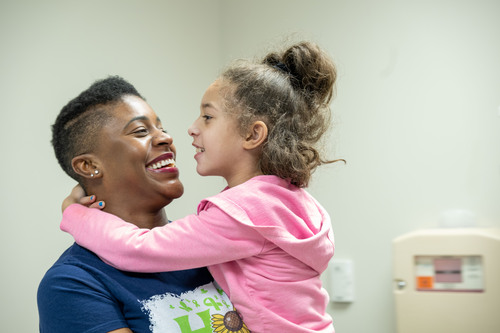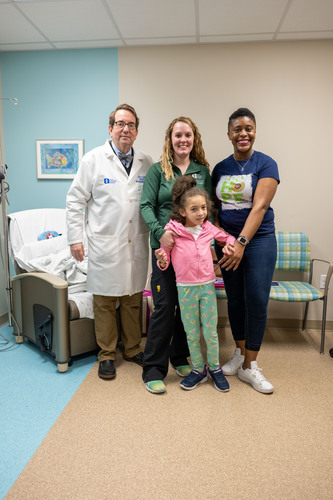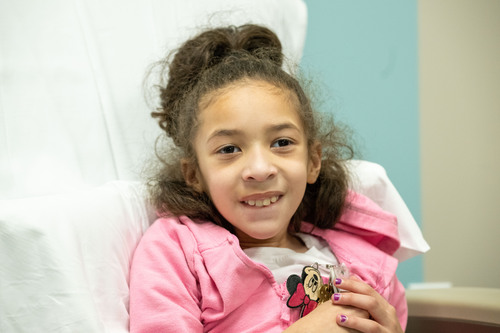When Valenica Soltys’ toddler daughter Mia started stumbling when she walked, she knew something wasn’t right.
“She was the most perfect baby,” Valencia said of Mia. “She made all her milestones and did everything ahead of time. She started walking and around 13 months nothing was abnormal. So, there were no red flags for anything. And then around 15 or 16 months old, she started stumbling a little bit, and we thought maybe she stubbed her toe or something else was going on.”
Mia’s parents kept an eye on the busy toddler and noticed that instead of improving, her motor skills were getting worse. To get answers, the family had many appointments with doctors in New York. 
At first, Valencia felt like she wasn’t being heard, but after switching to a new doctor who urgently referred Mia to a neurologist, she was diagnosed with Leigh syndrome.
Leigh syndrome is a mitochondrial disease that causes progressive loss of mental and motor abilities. It is caused by mutations in genes involved in energy production in the mitochondria.
Symptoms of Leigh syndrome vary, but can include muscle and movement problems, seizures and muscle weakness. With no cure or specific treatment for Leigh syndrome, patients are treated based on symptoms.
At the time of Mia’s diagnosis, Valencia was pregnant with Mia’s sister, Cameryn, who also inherited Leigh syndrome.
“We started doing research and heard about this drug that was in the pipeline in 2015. And I said at some point, we’re going to try this,” Valencia said.
Mia and her family traveled from New York to the Mitochondrial Center at Akron Children’s to  participate in a clinical trial administered by Dr. Bruce Cohen and his staff.
participate in a clinical trial administered by Dr. Bruce Cohen and his staff.
“This center stood out to us in terms of accessibility. The response from the clinical team when I reached out for questions was great. I feel like a lot can be said in terms of how an individual or an organization responds, and that was the driving force when choosing Akron,” Valencia said. “With other places that I’ve reached out to in the past, it wasn’t a direct answer or contact that I had. But once I started here, the communication has been outstanding and the most important thing, because this is such a complicated situation.
Dr. Cohen is amazing. We’ve been working with the staff through the entire process, and they’re the ones that keep us coming back. Some doctors forget the individual attributes of the human who they’re treating, but that’s not the case with Dr. Cohen. That is my favorite part. We’ve seen a lot of doctors throughout our journey, and he’s one of the most memorable.”
It’s important to the Soltys family that their daughters are treated as humans, not just looked at as a diagnosis.
“We use all our resources as family to support them as humans instead of a diagnosis. We’ve done lots of physical therapy, occupational therapy, speech therapy, and we meet them where they are,” Valencia explained. “We know this is an energy situation, so we let them guide us in terms of what they’re able to tolerate without overdoing it. It’s important to get the most out of all the therapies and all the different interventions that we’re doing without making this their entire life.”
Over the course of 72 weeks, Mia received a medication three times per day. She checked in with the center monthly either virtually or visiting from New York.
“I’ve noticed a difference cognitively for her. I feel like cognitively it has helped,” she said.
Now, a smiley, social nine-year-old, Mia recently had a great time at her school dance.
“Mia does not fit into any box. Mia is kind and she loves people. She definitely has a mind of her own and has lots of opinions. She is spicy. And honestly that fire has been the driving force for us,” Valencia said. “Because if she’s okay to do something, then we do it. She brings so much light and life into everything that she’s a part of. There isn’t a human who has met her who isn’t amazed by her journey and just how far she’s come.”
One thing that stands out to Valencia about Dr. Cohen and the providers at the Mitochondrial Center is the honesty and communication amongst the team.
“I really appreciate the honesty and communication that’s provided,” she said. “We’re honest with each other. It’s an open line of communication. It is genuine. I feel like everyone cares about Mia as a human and not just numbers for a trial. Our family is taken into consideration when we choose to do something, the fact that we might need to change multiple things about our trip because of whatever is happening with the girls. It feels more like a journey instead of just checking boxes.”
Mia’s nurses at the center – and Dr. Cohen – are always happy to see her when she arrives, knowing she prefers a warm blanket over her feet and the door to her room closed.
Though Leigh syndrome can be a scary diagnosis for a child and their family to receive, Valencia wants parents to know there is hope.
“Leigh syndrome is not a death sentence. Leigh syndrome is complicated, and it is so different for each individual,” she said. “They need to know they’re treating an individual not a diagnosis. My children have the same genetic diagnosis, but they’re different in terms of cognitive ability, their energy levels, and what they’re able to do on a daily basis. Leigh syndrome could be a devastating diagnosis, but there’s so much hope at this point in terms of trials in terms of treatments. The big thing is treating the individual and not the diagnosis.”










